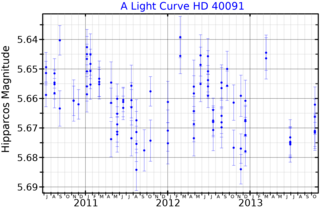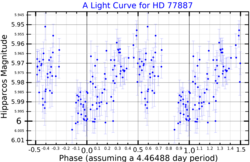
NO Apodis is a solitary, red hued variable star located in the southern circumpolar constellation Apus. It has an average apparent magnitude of 5.86, allowing it to be faintly seen with the naked eye. The object is relatively far at a distance of 790 light years but is drifting closer with a heliocentric radial velocity −18.3 km/s.

HD 27245, also known as HR 1335 or rarely 25 H. Camelopardalis is a solitary red-hued star located in the northern circumpolar constellation Camelopardalis. It has an apparent magnitude of 5.4, making it faintly visible to the naked eye. Gaia DR3 Parallax measurements place it approximately 607 light years away from it the Solar System and is drifting further away with a heliocentric radial velocity of 25.2 km/s. At its current distance, HD 27245's brightness is diminished by 0.36 magnitudes due to extinction from interstellar dust. It has an absolute magnitude of −0.27.
HD 63399 is an orange hued star located in the southern constellation Puppis, the poop deck. It has an apparent magnitude of 6.45, placing it near the limit for naked eye visibility. Based on parallax measurements from Gaia DR3, the object is estimated to be 445 light years distant. It appears to be receding with a spectroscopic radial velocity of 28.5 km/s. At its current distance, HD 63399 is diminished by 0.29 magnitudes due to interstellar dust.

HD 93905 is a solitary star located in the southern constellation Antlia. The star has an absolute magnitude of 0 and an apparent magnitude of 5.61, making it faintly visible to the naked eye under ideal conditions. The star is located 371 light years away based on its parallax shift and is drifting closer with a helocentric radial velocity of −9.6 km/s.
HD 121439, also known as HR 5240, is a solitary, bluish-white hued star located in the southern circumpolar constellation Apus. It has an apparent magnitude of 6.08, allowing it to be faintly visible to the naked eye. The object is located relatively far at a distance of 774 light years based on Gaia DR3 parallax measurements but is receding with a fairly constrained radial velocity of 4 km/s. At its current distance, HD 121439's brightness is diminished by 0.57 magnitudes due to interstellar dust.

HD 57197, also known as M Puppis or HR 2789, is a suspected astrometric binary located in the southern constellation Puppis, the poop deck. It has an apparent magnitude of 5.84, making it faintly visible to the naked eye under ideal conditions. Based on parallax measurements from the Gaia satellite, the system is estimated to be 629 light years away from the Solar System. The value is poorly constrained, but it appears to be receding with a heliocentric radial velocity of 13 km/s. At its current distance, HD 57197's brightness is diminished by 0.3 magnitudes due to interstellar dust. It has an absolute magnitude of -0.43.
HD 35184 is a solitary star in the southern circumpolar constellation Mensa. It has an apparent magnitude of 6.50, which the maximum naked eye visibility. Located 375 light years away, it is receding with a heliocentric radial velocity of 13.6 km/s.

HD 174387 is a solitary star in the southern constellation Telescopium. With an apparent magnitude of 5.49, it is faintly visible to the naked eye if viewed under dark skies. Parallax measurements put the object at a distance of 810 light years and it is currently approaching the Solar System with a heliocentric radial velocity of −28.1 km/s.
HD 170069 is a solitary star in the southern constellation Telescopium. It has an apparent magnitude of 5.68, allowing it to be faintly seen with the naked eye. The star is located at a distance of 590 light years but is approaching closer with a heliocentric radial velocity of −18 km/s. HD 170069 was designated as Tau Telescopii before Benjamin Apthorp Gould dropped the title.
HD 194612 is a solitary orange hued star located in the southern circumpolar constellation Octans. It has an apparent magnitude of 5.9, making it visible to the naked eye under ideal conditions. Parallax measurements place it at a distance of 760 light years and it has a low heliocentric radial velocity of 0.3 km/s.
HD 37289, also known as HR 1916, is a solitary, orange hued star located in the northern circumpolar constellation Camelopardalis. It has an apparent magnitude of 5.61, making it faintly visible to the naked eye under ideal conditions. Based on parallax measurements from the Gaia spacecraft, the object is estimated to be 308 light years distant. It appears to be approaching the Sun, having a heliocentric radial velocity of −20.7 km/s.

WZ Columbae, also known as HD 38170, is a solitary, bluish-white hued star located in the southern constellation Columba, the dove. It has an apparent magnitude of 5.28, allowing it to be faintly visible to the naked eye. Based on parallax measurements from the Gaia spacecraft, the object is about 365 light years distant. It appears to be receding from the Solar System, having a heliocentric radial velocity of 36.3 km/s.

CW Octantis, also known as HD 148542, is a solitary, white hued variable star located in the southern circumpolar constellation Octans. It has an apparent magnitude of 6.03, allowing it to be faintly visible to the naked eye. Parallax measurements from Gaia DR3 place the object at a distance of 629 light years. It appears to be receding from the Solar System with a heliocentric radial velocity of 7.1 km/s.
HD 31529, also known as HR 1584, is a solitary, orange hued star located in the southern constellation Caelum, the chisel. It has an apparent magnitude of 6.09, making it faintly visible to the naked eye if viewed under ideal conditions. This object is located relatively far at a distance of 932 light years based on parallax measurements from Gaia DR3, but is receding with a heliocentric radial velocity of 28.4 km/s. Eggen (1989) lists it as a member of the old disk population.

HD 40091, also known as HR 2082, is a solitary star located in the southern constellation Columba, the dove. It has an apparent magnitude of 5.54, making it faintly visible to the naked eye under ideal conditions. Based on parallax measurements from the Gaia spacecraft, the object is estimated to be 501 light years distant. However, it is rapidly receding with a high heliocentric radial velocity of 114 km/s.

HD 168592, also designated as HR 6862 or rarely 7 G. Coronae Australis, is a solitary star located in the southern constellation Corona Australis. It is faintly visible to the naked eye as an orange-hued star with an apparent magnitude of 5.07. Gaia DR3 parallax measurements place it at a distance of 490 light years and is currently receding with a heliocentric radial velocity of 18 km/s. At its current distance, HD 168592's brightness is diminished by 0.38 magnitudes due to interstellar dust. It has an absolute magnitude of −0.76.

HD 193002 is a solitary red hued star located in the southern constellation Telescopium. It has an apparent magnitude of 6.26, placing it near the limit for naked eye visibility, even under ideal conditions. The object is located relatively far at a distance of 1,030 light years based on Gaia DR3 parallax measurements, but it is approaching the Solar System with a heliocentric radial velocity of −9.1 km/s. At its current distance, HD 193002's brightness is diminished by 0.17 magnitudes due to interstellar dust and it has an absolute magnitude of −0.93.

HD 192827, also known as HR 7745 or rarely 83 G. Telescopii, is a solitary red hued star located in the southern constellation Telescopium. It has an apparent magnitude of 6.28, placing it near the limit for naked eye visibility. The object is located relatively far at a distance of 1,320 light years based on Gaia DR3 parallax measurements, but it is approaching with a heliocentric radial velocity of −43.7 km/s. At its current distance, HD 192827's brightness is diminished by 0.19 magnitudes due to interstellar dust and it has an absolute magnitude of −1.07.

HD 170521, also known as HR 6937 or rarely 12 G. Coronae Australis, is a solitary star located in the southern constellation Corona Australis. It is faintly visible to the naked eye as an orange-hued point of light with an apparent magnitude of 5.69. The object is located relatively far at a distance of approximately 1,500 light years based on Gaia DR3 parallax measurements, and it is receding with a heliocentric radial velocity of 7.2 km/s. At its current distance, HD 170521's brightness is heavily diminished by 0.46 magnitudes due to extinction from interstellar dust and it has an absolute magnitude of −1.90.

HD 11928 is a solitary star located in the northern constellation of Triangulum. It is faintly visible to the naked eye as a red-hued point of light with an apparent magnitude of 5.85. Gaia DR3 parallax measurements imply a distance of 530 light-years and it is drifting closer with a heliocentric radial velocity of −1.93 km/s. At its current distance, HD 11928's brightness is diminished by an interstellar extinction of 0.13 magnitudes and it has an absolute magnitude of +0.11.










